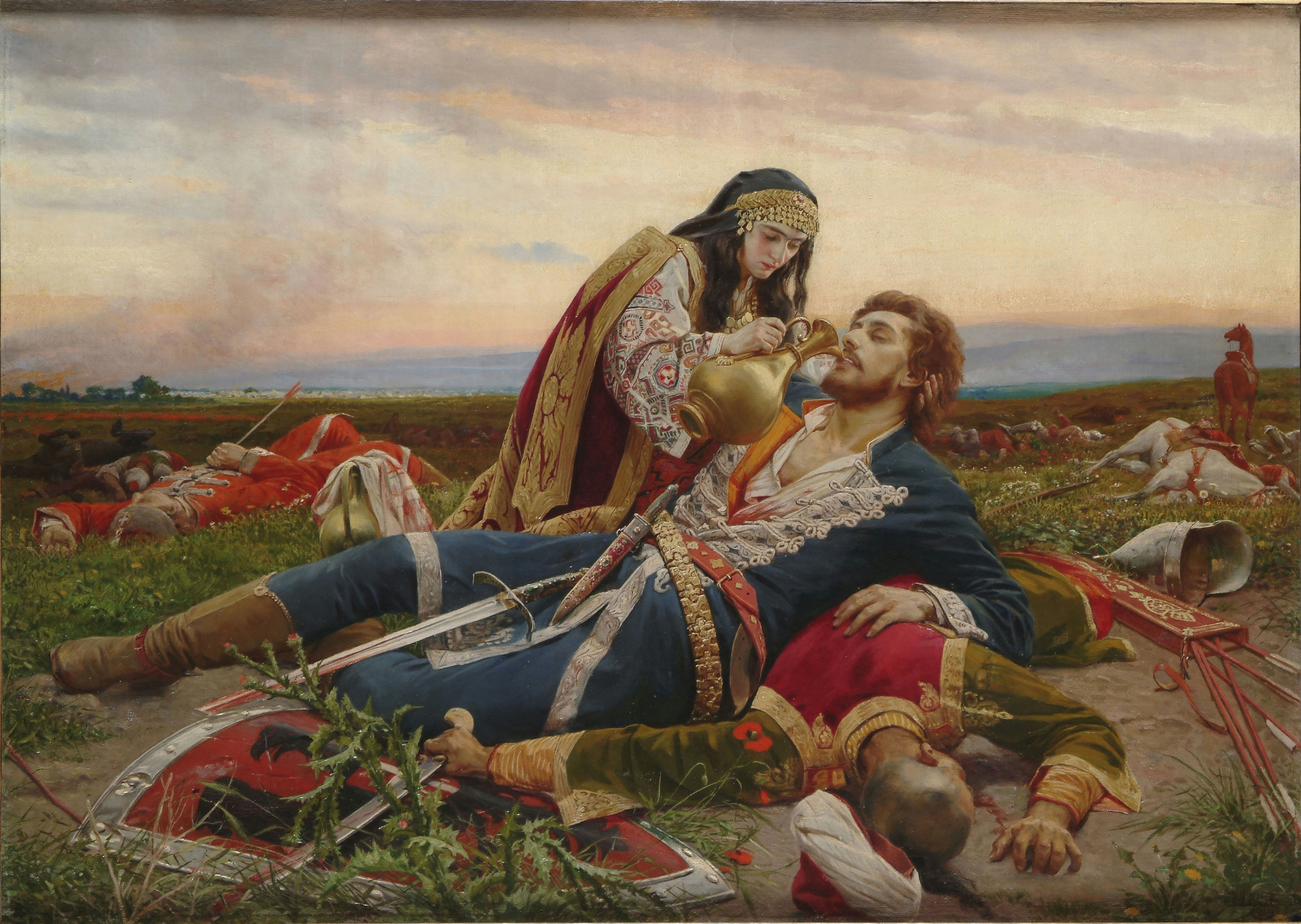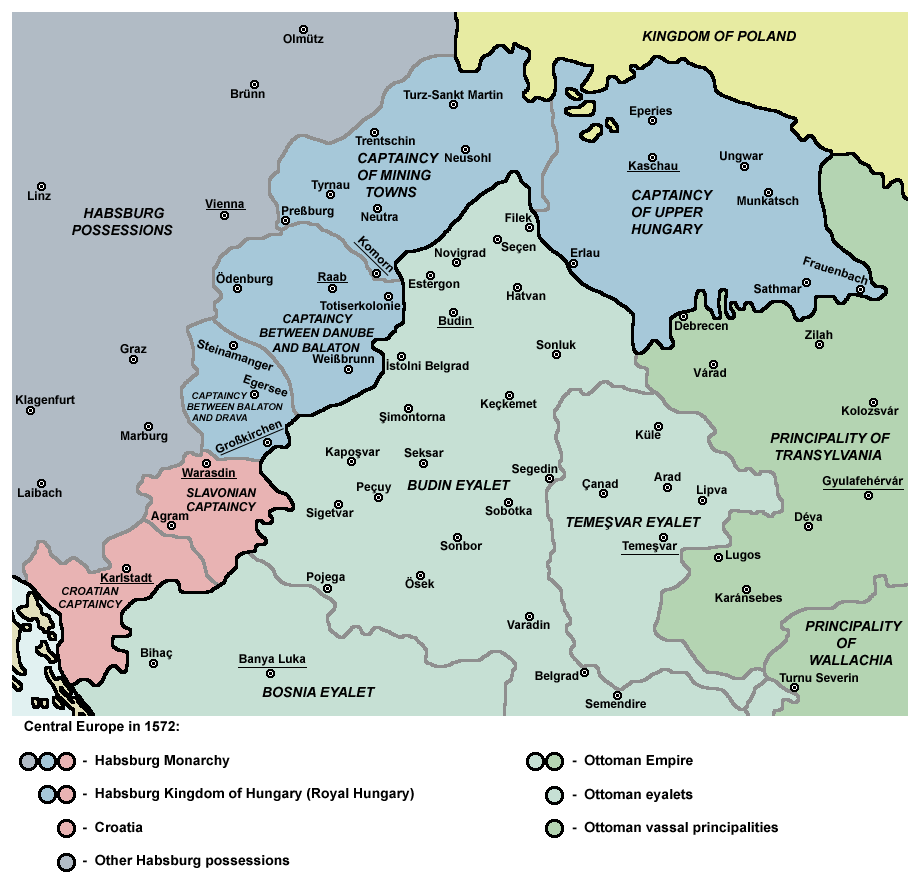|
Eğri Eyalet
Eğri Eyalet ( ota, ایالت اگیر; Eyālet-i Egīr, hu, Egri vilajet, sr, Jegarski ejalet or Јегарски ејалет) or Pashaluk of Eğri was an administrative territorial entity of the Ottoman Empire formed in 1596 with its capital at Eğri (Hungarian: Eger). It included parts of present-day Hungary and Slovakia. The population of the province was ethnically and religiously diverse and included Slovaks and Hungarians (living mainly in the north), Serbs (living mainly in the south), and Muslims of various ethnic origins (living mainly in the cities). Other ethnic communities included Jews and Romani. Administrative divisions The province included the following sanjaks:http://dergiler.ankara.edu.tr/dergiler/19/1267/14566.pdf Macaristan'da Osmanlı Hakimiyetinin ve İdari Teşkilatının Kuruluşu ve Gelişmesi, Sadık Müfit Bilge # Sanjak of Eğri (Eger) # Sanjak of Segedin (Szeged) # Sanjak of Sonluk (Szolnok) # Sanjak of Seçen ( Szécsény) # Sanjak of Hatv ... [...More Info...] [...Related Items...] OR: [Wikipedia] [Google] [Baidu] |
Eyalet
Eyalets ( Ottoman Turkish: ایالت, , English: State), also known as beylerbeyliks or pashaliks, were a primary administrative division of the Ottoman Empire. From 1453 to the beginning of the nineteenth century the Ottoman local government was loosely structured. The empire was at first divided into states called eyalets, presided over by a beylerbey (title equivalent to duke in Turkish) of three tails (feathers borne on a state officer's ceremonial staff). The grand vizier was responsible for nominating all the high officers of State, both in the capital and the states. Between 1861 and 1866, these eyalets were abolished, and the territory was divided for administrative purposes into vilayets (provinces). The eyalets were subdivided into districts called livas or sanjaks, each of which was under the charge of a pasha of one tail, with the title of mira-lira, or sanjak-bey. These provinces were usually called pashaliks by Europeans. [...More Info...] [...Related Items...] OR: [Wikipedia] [Google] [Baidu] |
Sanjak Of Seçen
Sanjaks (liwāʾ) (plural form: alwiyāʾ) * Armenian: նահանգ (''nahang''; meaning "province") * Bulgarian: окръг ('' okrǔg''; meaning "county", "province", or "region") * el, Διοίκησις (''dioikēsis'', meaning "province") or επαρχία (''eparchia'', meaning "eparchy") * lad, sancak , group=note (; ota, ; Modern Turkish: ''Sancak'', ) were administrative divisions of the Ottoman Empire. ''Sanjak'', and the variant spellings ''sandjak'', ''sanjaq'' and ''sinjaq'', are English or French transliterations of the Turkish word ''sancak'', meaning "district", "banner" or "flag". Sanjaks were also called by the Arabic word for ''banner'' or ''flag'': '' liwa (Liwā or Liwā’)''. Ottoman provinces (eyalets, later vilayets) were divided into sanjaks (also called ''livas'') governed by sanjakbeys (also called ''Mutesarriff'') and were further subdivided into ''timars'' (fiefs held by ''timariots''), kadiluks (the area of responsibility of a judge, or K ... [...More Info...] [...Related Items...] OR: [Wikipedia] [Google] [Baidu] |
Ottoman Period In Slovakia
Ottoman is the Turkish spelling of the Arabic masculine given name Uthman ( ar, عُثْمان, ‘uthmān). It may refer to: Governments and dynasties * Ottoman Caliphate, an Islamic caliphate from 1517 to 1924 * Ottoman Empire, in existence from 1299 to 1922 ** Ottoman dynasty, ruling family of the Ottoman Empire *** Osmanoğlu family, modern members of the family * Ottoman architecture Ethnicities and languages * Ottoman Armenians, the Armenian ethnic group in the Ottoman Empire * Ottoman Greeks, the Greek ethnic group in the Ottoman Empire * Ottoman Serbs, the Serbian ethnic group in the Ottoman Empire * Ottoman Turks, the Turkic ethnic group in the Ottoman Empire ** Ottoman Turkish alphabet ** Ottoman Turkish language, the variety of the Turkish language that was used in the Ottoman Empire Products * Ottoman bed, a type of storage bed * Ottoman (furniture), padded stool or footstool * Ottoman (textile), fabric with a pronounced ribbed or corded effect, often made of silk or ... [...More Info...] [...Related Items...] OR: [Wikipedia] [Google] [Baidu] |
History Of Ottoman Serbia
Most of the territory of what is now the Republic of Serbia was part of the Ottoman Empire throughout the Early Modern period, especially Central Serbia and Southern Serbia, unlike Vojvodina which had passed to Habsburg rule starting from the end of the 17th century (with several takeovers of Central Serbia as well). In the 14th and 15th centuries, the Serbian Despotate was conquered by the Ottoman Empire as part of the Ottoman conquest of the Balkans. The Ottomans defeated the Serbs at the Battle of Maritsa in 1371, making vassals of the southern governors. Soon thereafter, Serbian Emperor Stefan Uroš V died; as he was childless and the nobility could not agree on the rightful heir, the Empire was subsequently ruled by semi-independent provincial lords, who often were in feuds with each other. The most powerful of these, Lazar of Serbia, the Duke of a region now encompassing present-day central Serbia, that had not yet fallen under Ottoman rule, confronted the Ottomans at t ... [...More Info...] [...Related Items...] OR: [Wikipedia] [Google] [Baidu] |
Ottoman Hungary
Ottoman Hungary ( hu, Török hódoltság) was the southern and central parts of what had been the Kingdom of Hungary in the late medieval period, which were conquered and ruled by the Ottoman Empire from 1541 to 1699. The Ottoman rule covered almost the entire region of the Great Hungarian Plain (except the northeastern parts) and Southern Transdanubia. The territory was invaded and annexed to the Ottoman Empire by Sultan Suleiman the Magnificent between 1521 and 1541. The north-western rim of the Hungarian kingdom remained unconquered and recognised members of the House of Habsburg as Kings of Hungary, giving it the name "Royal Hungary". The boundary between the two thereupon became the frontline in the Ottoman–Habsburg wars over the next 150 years. Following the defeat of the Ottomans in the Great Turkish War, most of Ottoman Hungary was ceded to the Habsburgs under the Treaty of Karlowitz in 1699. During the period of Ottoman rule, Hungary was divided for administrative ... [...More Info...] [...Related Items...] OR: [Wikipedia] [Google] [Baidu] |
Long War (Ottoman Wars)
The Long Turkish War or Thirteen Years' War was an indecisive land war between the Habsburg monarchy and the Ottoman Empire, primarily over the Principalities of Wallachia, Transylvania, and Moldavia. It was waged from 1593 to 1606 but in Europe it is sometimes called the Fifteen Years War, reckoning from the 1591–92 Turkish campaign that captured Bihać. In the series of Ottoman wars in Europe it was the major test of force between the Ottoman–Venetian War (1570–73) and the Cretan War (1645–69). The next of the major Ottoman–Habsburg wars was the Austro-Turkish War of 1663–1664. Overall, the conflict consisted in a large number of costly battles and sieges, but with little gain for either side. Overview The major participants of the war were the Habsburg Monarchy, the Principality of Transylvania, Wallachia, and Moldavia opposing the Ottoman Empire. Ferrara, Tuscany, Mantua, and the Papal State were also involved to a lesser extent. War funding Th ... [...More Info...] [...Related Items...] OR: [Wikipedia] [Google] [Baidu] |
Sanjak Of Filek
Sanjaks (liwāʾ) (plural form: alwiyāʾ) * Armenian: նահանգ (''nahang''; meaning "province") * Bulgarian: окръг (''okrǔg''; meaning "county", "province", or "region") * el, Διοίκησις (''dioikēsis'', meaning "province") or επαρχία (''eparchia'', meaning "eparchy") * lad, sancak , group=note (; ota, ; Modern Turkish: ''Sancak'', ) were administrative divisions of the Ottoman Empire. ''Sanjak'', and the variant spellings ''sandjak'', ''sanjaq'' and ''sinjaq'', are English or French transliterations of the Turkish word ''sancak'', meaning "district", "banner" or "flag". Sanjaks were also called by the Arabic word for ''banner'' or ''flag'': '' liwa (Liwā or Liwā’)''. Ottoman provinces (eyalets, later vilayets) were divided into sanjaks (also called ''livas'') governed by sanjakbeys (also called ''Mutesarriff'') and were further subdivided into ''timars'' (fiefs held by ''timariots''), kadiluks (the area of responsibility of a judge, or Kadı) ... [...More Info...] [...Related Items...] OR: [Wikipedia] [Google] [Baidu] |
Sanjak Of Novigrad
Sanjaks (liwāʾ) (plural form: alwiyāʾ) * Armenian: նահանգ (''nahang''; meaning "province") * Bulgarian: окръг (''okrǔg''; meaning "county", "province", or "region") * el, Διοίκησις (''dioikēsis'', meaning "province") or επαρχία (''eparchia'', meaning "eparchy") * lad, sancak , group=note (; ota, ; Modern Turkish: ''Sancak'', ) were administrative divisions of the Ottoman Empire. ''Sanjak'', and the variant spellings ''sandjak'', ''sanjaq'' and ''sinjaq'', are English or French transliterations of the Turkish word ''sancak'', meaning "district", "banner" or "flag". Sanjaks were also called by the Arabic word for ''banner'' or ''flag'': '' liwa (Liwā or Liwā’)''. Ottoman provinces (eyalets, later vilayets) were divided into sanjaks (also called ''livas'') governed by sanjakbeys (also called ''Mutesarriff'') and were further subdivided into ''timars'' (fiefs held by ''timariots''), kadiluks (the area of responsibility of a judge, or Kadı) ... [...More Info...] [...Related Items...] OR: [Wikipedia] [Google] [Baidu] |
_1803.jpg)


